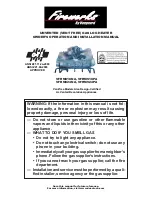
www.desatech.com
21
113048-01F
WARNING: If you smell gas
• Shut off gas supply.
• Do not try to light any appliance.
• Do not touch any electrical switch; do not use any phone in your
building.
• Immediately call your gas supplier from a neighbor’s phone. Fol-
low the gas supplier’s instructions.
• If you cannot reach your gas supplier, call the fire department.
IMPORTANT:
Operating heater where impurities in air exist may create odors. Cleaning supplies,
paint, paint remover, cigarette smoke, cements and glues, new carpet or textiles, etc., create fumes.
These fumes may mix with combustion air and create odors.
POSSIBLE CAUSE
1. Metal expanding while heat-
ing or contracting while
cooling
1. Heater burning vapors from
paint, hair spray, glues, etc.
(see
IMPORTANT
state-
ment above)
2. Low fuel supply (propane/LP
gas only)
3. Gas leak.
See Warning
statement above
1. Not enough fresh air is avail-
able
2. Low line pressure
3. ODS/pilot is partially
clogged
1. Gas leak.
See Warning
statement above
2. Control valve defective
1. Foreign matter between
control valve and burner
2. Gas leak.
See Warning
statement above
1. Not enough combustion/ven-
tilation air
OBSERVED PROBLEM
Heater produces a clicking/tick-
ing noise just after burner is lit
or shut off
Heater produces unwanted odors
Heater shuts off in use (ODS
operates)
Gas odor even when control knob
is in OFF position
Gas odor during combustion
Moisture/condensation noticed
on windows
REMEDY
1. This is common with most heat-
ers. If noise is excessive, contact
qualified service person
1. Ventilate room. Stop using
odor causing products while
heater is running
2. Refill supply tank
3. Locate and correct all leaks
(see
Checking Gas Connec-
tions
, page 12)
1. Open window and/or door for
ventilation
2. Contact local natural or pro-
pane/LP gas company
3. Clean ODS/pilot (see
Cleaning
and Maintenance
, page 19)
1. Locate and correct all leaks
(see
Checking Gas Connec-
tions
, page 12)
2. Replace control valve
1. Take apart gas tubing and
remove foreign matter
2. Locate and correct all leaks
(see
Checking Gas Connec-
tions,
page 12)
1. Refer to
Air for Combustion
and Ventilation
requirements
(page 5)
TROUBLESHOOTING
Continued












































